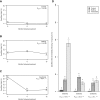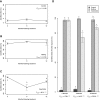Insecticide-impregnated netting as a potential tool for long-lasting control of the leishmaniasis vector Lutzomyia longipalpis in animal shelters
- PMID: 23642213
- PMCID: PMC3658972
- DOI: 10.1186/1756-3305-6-133
Insecticide-impregnated netting as a potential tool for long-lasting control of the leishmaniasis vector Lutzomyia longipalpis in animal shelters
Abstract
Background: Leishmaniasis remains a serious neglected disease, with more than 350 million people potentially at risk worldwide. Control strategies often rely on spraying residual insecticides to target populations of the sand fly vectors that transmit Leishmania parasites when blood-feeding. These programmes are often difficult to sustain effectively, as sand fly resting sites must be resprayed on a regular basis. Here, we investigate whether application of insecticide-impregnated netting to a surface could act as an alternative to residual spraying for controlling the American visceral leishmaniasis vector Lutzomyia longipalpis.
Methods: Female L. longipalpis from our laboratory colony were exposed for 1 h to three treatments applied to plywood surfaces: 2% permethrin-impregnated netting (Olyset®), 20 mg a.i.m-2 micro-encapsulated lambda-cyhalothrin (Demand CS®) and a no-treatment control. We compared the speed at which these treatments acted, by measuring the percentage of sand flies killed both immediately after exposure to the treatment for 1 hour, as well as the number that had died 24 h after the 1 hour exposure. We repeated the experiment at 6 and 12 months following application to test the effectiveness of each treatment over time.
Results: When first applied, the lambda-cyhalothrin killed more sand flies in the first hour than the permethrin-impregnated netting. However, the effectiveness of the lambda-cyhalothrin diminished over time, so that there was no difference between the two treatments at 12 months. Both killed more sand flies than the control. When measured 24 h following exposure, both test treatments had killed close to 100% of sand flies when first applied, but while the lethal effect of the netting was maintained at close to 100% over 12 months, the effectiveness of the residual insecticide diminished to approximately 80% after 6 months.
Conclusions: The results of these initial laboratory experiments indicate that covering surfaces with insecticide impregnated netting material may provide a longer-lasting solution for killing sand flies than residual spraying. Field trials are needed to identify the feasibility of treating surfaces with netting or similar impregnated materials as part of a control program. In targeting L. longipalpis, the greatest benefits may be seen in treating animal sheds with netting, where these sand flies aggregate in large numbers, and which can be difficult to treat repeatedly by conventional spraying.
Figures


Similar articles
-
Insecticide-impregnated netting: A surface treatment for killing Lutzomyia longipalpis (Diptera: Psychodidae), the vector of Leishmania infantum.Curr Res Parasitol Vector Borne Dis. 2021;1:None. doi: 10.1016/j.crpvbd.2021.100044. Curr Res Parasitol Vector Borne Dis. 2021. PMID: 35005688 Free PMC article.
-
Susceptibility of wild-caught Lutzomyia longipalpis (Diptera: Psychodidae) sand flies to insecticide after an extended period of exposure in western São Paulo, Brazil.Parasit Vectors. 2019 Mar 14;12(1):110. doi: 10.1186/s13071-019-3364-4. Parasit Vectors. 2019. PMID: 30871639 Free PMC article.
-
Insecticide-impregnated dog collars for the control of visceral leishmaniasis: evaluation of the susceptibility of field Lutzomyia longipalpis populations to deltamethrin.Parasit Vectors. 2024 Nov 15;17(1):468. doi: 10.1186/s13071-024-06474-4. Parasit Vectors. 2024. PMID: 39548568 Free PMC article.
-
[Prevention and control of leishmaniasis vectors: current approaches].Parassitologia. 2004 Jun;46(1-2):211-5. Parassitologia. 2004. PMID: 15305719 Review. Italian.
-
Sand Flies and Their Control Methods.Turkiye Parazitol Derg. 2017 Jun;41(2):102-113. doi: 10.5152/tpd.2017.5296. Turkiye Parazitol Derg. 2017. PMID: 28695834 Review.
Cited by
-
Synthesis and antileishmanial evaluation of some 2,3-disubstituted-4(3H)-quinazolinone derivatives.Org Med Chem Lett. 2014 Dec;4(1):10. doi: 10.1186/s13588-014-0010-1. Epub 2014 Sep 17. Org Med Chem Lett. 2014. PMID: 26548988 Free PMC article.
-
Insecticide-impregnated netting: A surface treatment for killing Lutzomyia longipalpis (Diptera: Psychodidae), the vector of Leishmania infantum.Curr Res Parasitol Vector Borne Dis. 2021;1:None. doi: 10.1016/j.crpvbd.2021.100044. Curr Res Parasitol Vector Borne Dis. 2021. PMID: 35005688 Free PMC article.
-
Management of canine leishmaniosis in endemic SW European regions: a questionnaire-based multinational survey.Parasit Vectors. 2014 Mar 24;7:110. doi: 10.1186/1756-3305-7-110. Parasit Vectors. 2014. PMID: 24656172 Free PMC article.
-
Synthetic sex pheromone in a long-lasting lure attracts the visceral leishmaniasis vector, Lutzomyia longipalpis, for up to 12 weeks in Brazil.PLoS Negl Trop Dis. 2014 Mar 20;8(3):e2723. doi: 10.1371/journal.pntd.0002723. eCollection 2014 Mar. PLoS Negl Trop Dis. 2014. PMID: 24651528 Free PMC article.
-
Susceptibility of wild-caught Lutzomyia longipalpis (Diptera: Psychodidae) sand flies to insecticide after an extended period of exposure in western São Paulo, Brazil.Parasit Vectors. 2019 Mar 14;12(1):110. doi: 10.1186/s13071-019-3364-4. Parasit Vectors. 2019. PMID: 30871639 Free PMC article.
References
-
- WHO Expert Committee. Control of the leishmaniasis: report of a meeting of the WHO expert committee on the control of leishmaniases, Geneva, 22-26 March 2010. Who Tech Rep Ser. 2010;949:1–186.
-
- Noazin S, Khamesipour A, Moulton LH, Tanner M, Nasseri K, Modabber F, Sharifi I, Khalil EAG, Bernal IDV, Antunes CMF, Smith PG. Efficacy of killed whole-parasite vaccines in the prevention of leishmaniasis: a meta-analysis. Vaccine. 2009;27:4747–4753. doi: 10.1016/j.vaccine.2009.05.084. - DOI - PubMed
-
- Tesh R. Control of zoonotic visceral leishmaniasis - Is it time to change strategies? AmJTrop Med Hyg. 1995;52:287–292. - PubMed
Publication types
MeSH terms
Substances
Grants and funding
LinkOut - more resources
Full Text Sources
Other Literature Sources

